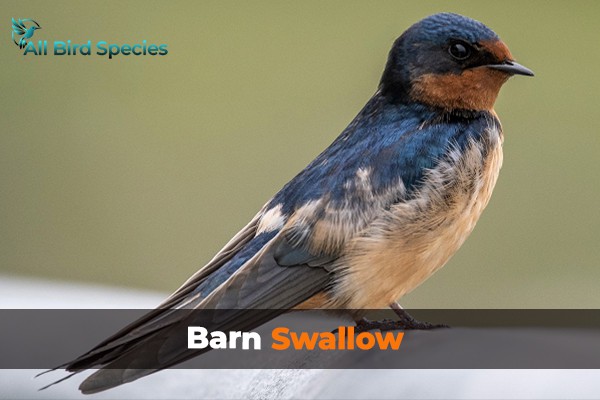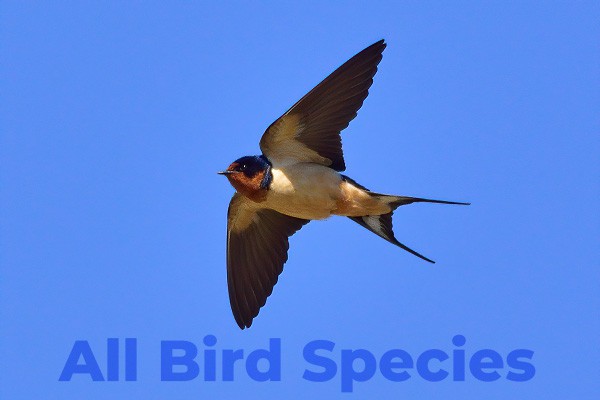Barn Swallow: A Symbol Of Spring
Did you know the barn swallow is the most common swallow bird, with 190 million flying high? This shows how important the barn swallow is. It’s a symbol of spring and shows nature’s strength.
The barn swallow is known for its beautiful flight and looks. It comes with the warmer days in the North, bringing renewal and hope.
In many cultures and stories, this bird is seen as a sign of the seasons changing. It’s a symbol we all love. Let’s dive into why the barn swallow is a symbol of spring and a favorite in nature.
Barn Swallow: Everything You Need To Know About This Bird
The barn swallow bird is truly iconic, known for its beauty and charm. It has iridescent navy-blue feathers that shine in the sun. The bright orange throat and forehead make it even more striking. The colors under its feathers can be bright orange or soft gray.
The barn swallow’s long, forked tail is very noticeable. Its slender body and tail make it easy to spot. Watching them fly and catch insects is exciting. It adds to the beauty of spring.
If you love birds or nature, the barn swallow is a treat in spring. Seeing them fly around in their bright colors is a joy. It reminds us of the beauty around us during this happy time.
Characteristics of the Barn Swallow
Barn swallows stand out with their unique look. They have an aerodynamic body and a deeply forked tail. This makes them easy to spot. Males shine with bright colors and long tail streamers. Females are more subtle in their colors.

Physical Appearance
The barn swallow’s look is quite charming. Here are the main features:
- Body Structure: Slender and built for speed.
- Coloration: Contrasting cream-white to rufous underparts, with a buff-colored face.
- Eyes and Bill: Beady eyes and a small black bill enhance their distinctive look.
Flight and Behavior
Watching barn swallows in flight shows their agility and how they hunt. They move quickly and make sharp turns. This helps them catch insects in mid-air or over water.
- Flight Style: Quick wingbeats paired with acrobatic movements.
- Feeding Practices: They primarily catch insects in mid-air or skim over water surfaces.
- Social Behavior: Often seen flying in small flocks, particularly near water during foraging periods.
The barn swallow’s unique traits make it a favorite among bird lovers and nature fans.
Barn Swallow Habitat and Distribution
Barn swallows live in many places. Knowing where they like to be helps us understand their travels and how they adapt.
Preferred Habitats
These birds do well near water. You can find them in:
- Fields and farmlands
- Wetlands and marshes
- Coastal regions
- Areas close to human settlements
They like places with lots of food and good spots to nest. Under eaves, bridges, or buildings are perfect for them. This shows how well they live with people.
Migration Patterns
Barn swallows make a big trip each year. From the U.S. and Canada, they go to Mexico and Central America. They come back in late summer or early fall.
Knowing where they go helps us see how they use the seasons. They move to find food and the right conditions.
| Habitat Type | Characteristics | Common Locations |
|---|---|---|
| Farmlands | Open spaces, crops, and water sources | U.S. Midwest, California |
| Wetlands | Rich in insects, plants, and water | Florida Everglades, Chesapeake Bay |
| Coastal Areas | Access to food from marine sources | Atlantic and Pacific coasts |
| Human Settlements | Structures for nesting and abundant insects | Urban areas, barns, and bridges |
Nesting Habits of the Barn Swallow
Barn swallows are fascinating creatures, especially when it comes to their nesting habits. They show great dedication in building their nests and caring for their young. This gives us a peek into their reproductive cycle.

Building the Nest
Barn swallows build their nests with skill. They use mud, dry grasses, and feathers to make a cup-shaped nest. These nests are often found under ledges, rafters, or inside barns, keeping their chicks safe.
Both the male and female swallows work together to build the nest. This shows their strong partnership during the incubation phase.
Egg Laying and Incubation
Female barn swallows lay about five eggs, which are white with reddish spots. The eggs are kept warm for 19 days by both parents. After 20 days, the young birds leave the nest to learn survival skills.
Diet of the Barn Swallow
Barn swallows are amazing birds known for their flying skills and eating habits. They eat flying insects because they are insectivorous birds. Knowing what they eat helps us understand how they hunt and behave.
What Do Barn Swallows Eat?
Their diet includes:
- Flies
- Bees
- Wasps
- Beetles
In warm months, they love the many insects in open areas. This lets them hunt insects easily in the air. They use their skills to catch insects that are moved by the environment.
Feeding Behavior
Barn swallows show off their flying skills when they eat. They often eat in groups, especially when they are making babies. This helps them find more food and catch insects better.
- Rapid flight maneuvers
- Sharp turns and quick dives
- Ability to snatch prey mid-air
This way of eating shows their natural hunting skills. It helps them get food from their surroundings.
Significance of the Barn Swallow in Culture
The barn swallow is very important in many cultures. It is seen as a symbol of spring, bringing joy and new beginnings. People all over the world feel hopeful when these birds come back.
The Symbolism of the Barn Swallow
In many places, the barn swallow means good luck and safe travels. People look forward to seeing them in spring. They think the warm weather is coming.
This shows how much the barn swallow means to us. It connects us to nature and our feelings.
Literary References
In books, the barn swallow stands for freedom and hope. Famous writers use it in their stories. This makes readers feel something special.
For example, T.S. Eliot and Shakespeare used it in their works. The barn swallow in art shows its deep meaning to us.
Conservation Status of Barn Swallows
Barn swallows are often seen flying freely, but their numbers are dropping. They face many threats to swallows. Things like losing their homes, pesticides, and climate change are big problems.
We need to work on barn swallow conservation to help them. These efforts are very important.
Threats to Barn-Swallow Populations
The environmental impacts on barn swallows are huge. Losing their homes in fields hurts their nesting spots. Pesticides also harm their food, making fewer insects for them to eat.
Climate change changes when and where they migrate and breed. This makes it hard for them to survive.

Conservation Efforts
There are many conservation programs for barn swallows trying to help. They focus on saving their homes and places to nest. Groups work to teach people why we need to protect these birds.
Getting the community involved in efforts to save swallows can make a big difference. This can really help their numbers grow again.
| Threats to Swallows | Impact | Conservation Strategies |
|---|---|---|
| Habitat Destruction | Decreased nesting locations | Restoration of natural habitats |
| Pesticide Use | Reduced food supply | Advocacy for pesticide regulation |
| Climate Change | Altered migration and breeding | Research and monitoring programs |
Interactions Between Barn Swallows and Humans
Barn swallows have been living with humans for a long time. They are known for their beautiful flight and living near people. Seeing barn swallows means the area is healthy and good for many living things.
The benefits of barn swallows go beyond looking nice. They eat lots of insects, which helps farmers by controlling pests. Many farmers like these birds because they help keep pests away from their crops and animals.
Humans and barn swallows can help each other. These birds often make their homes on buildings, showing they feel safe around people. This living together helps both species do well. It also lets people see how interesting these birds are.
But, there can be problems. The droppings from barn swallows can be a concern for people. Using kind ways to keep them away helps solve these issues. This way, the swallows stay safe and people are happy too.
Learning about how barn swallows and humans interact makes our lives better. It teaches us to respect wildlife and helps us protect it. By seeing the value of these small birds, we help keep our world healthy for everyone.
| Aspect | Details |
|---|---|
| Natural Pest Control | Barn swallows eat a significant number of insects, helping to reduce pest populations around farms. |
| Nesting Habits | They often build nests near human structures, promoting coexistence. |
| Management Challenges | Droppings may necessitate discussions around management, emphasizing the need for humane solutions. |
| Ecological Significance | Indicate a healthy environment, supporting a vibrant ecosystem including diverse species. |
Final Thoughts:
The barn swallow is not just a pretty bird; it’s key to our ecosystem. This overview shows how they add beauty and culture to our world. By appreciating their beauty and role, we learn why barn swallows matter in nature.
Looking at their traits, we see they stand out with their looks, actions, and how they live. Their way of migrating and eating shows how they fit into different places. This shows their ability to adapt and survive, which is amazing in nature.
Connecting with barn swallows helps us care more about our ecosystems. Seeing their value can motivate us to help protect them. It also makes us aware of the beauty and strength of wildlife around us.







